Assessment of the Effect of International Maritime Regulations on Air Quality in the Southern North Sea
Abstract
1. Introduction
2. Methods
2.1. Belgian Coastguard Aircraft and Sniffer Sensor
2.1.1. Sniffer Sensor
2.1.2. FSC Measurements
2.1.3. NOx Measurements
2.1.4. Measurement Quality, Uncertainty, and Reporting Thresholds
2.2. Thetis–EU
2.2.1. Keel Laying Date
2.2.2. EGCS Data
2.3. Inland Air Quality Measurement Data
2.3.1. Inland Coastal Data and Non-Coastal Data
2.3.2. Trend Analysis by Emission Source
2.4. Statistical Analysis
3. Results and Discussion
3.1. Belgian Airborne Monitoring Dataset
3.2. Mean FSC and Compliance Trends
3.3. Real World NOx Emissions and Compliance Trends
3.4. Impact Emissions from OGVs on BELGIAN Inland Air Quality
4. Conclusions
Supplementary Materials
Author Contributions
Funding
Institutional Review Board Statement
Informed Consent Statement
Data Availability Statement
Acknowledgments
Conflicts of Interest
References
- Cromar, K.; Lazrak, N. Risk Communication of Ambient Air Pollution in the WHO European Region: Review of Air Quality Indexes and Lessons Learned; WHO: Denmark, Copenhagen, 2023. [Google Scholar]
- Burnett, R.; Chen, H.; Szyszkowicz, M.; Fann, N.; Hubbell, B.; Pope, C.A., 3rd; Apte, J.S.; Brauer, M.; Cohen, A.; Weichenthal, S.; et al. Global estimates of mortality associated with long-term exposure to outdoor fine particulate matter. Proc. Natl. Acad. Sci. USA 2018, 115, 9592–9597. [Google Scholar] [CrossRef] [PubMed]
- EEA. Air Quality in Europe. 2022. Available online: https://www.eea.europa.eu/publications/air-quality-in-europe-2022 (accessed on 18 April 2023).
- Byčenkienė, S.; Khan, A.; Bimbaitė, V. Impact of PM2.5 and PM10 Emissions on Changes of Their Concentration Levels in Lithuania: A Case Study. Atmosphere 2022, 13, 1793. [Google Scholar] [CrossRef]
- EEA. Indicator Assessment–Nitrogen Oxides (NOx) Emissions. Available online: https://www.eea.europa.eu/data-and-maps/indicators/eea-32-nitrogen-oxides-nox-emissions-1/assessment.2010-08-19.0140149032-3 (accessed on 11 April 2022).
- Corbett, J.; Fischbeck, P.S.; Pandis, S. Global nitrogen and sulfur inventories for oceangoing ships. J. Geophys. Res. Atmos. 1999, 104, 3457–3470. [Google Scholar] [CrossRef]
- Corbett, J.J.; Wang, C.; Winebrake, J.J.; Green, E. Allocation and Forecasting of Global Ship Emissions ANNEX Allocation and Forecasting of Global Ship Emissions Prepared for the Clean Air Task Force; Clean Air Task Force: Boston, MA, USA, 2007. [Google Scholar]
- Corbett, J.J.; Fischbeck, P. Emissions from Ships. Science 1997, 278, 823–824. [Google Scholar] [CrossRef]
- Corbett, J.J.; Koehler, H.W. Updated emissions from ocean shipping. J. Geophys. Res. 2003, 108, 3751. [Google Scholar] [CrossRef]
- IMO. Third IMO GHG Study 2014 Executive Summary and Final Report; IMO: London, UK, 2015. [Google Scholar]
- Faber, J.; Hanayama, S.; Zhang, S.; Pereda, P.; Comer, B.; Hauerhof, E.; Schim van der Loeff, W.; Smith, T.; Zhang, Y.; Kosaka, H.; et al. Fourth IMO GHG Study 2020 Full Report; IMO: London, UK, 2021. [Google Scholar]
- EMSA Tackling Emissions–Air Pollutants. Available online: https://www.emsa.europa.eu/tackling-air-emissions/air-pollutants.html (accessed on 18 April 2023).
- Zhang, Y.; Eastham, S.D.; Lau, A.K.; Fung, J.C.; E Selin, N. Global air quality and health impacts of domestic and international shipping. Environ. Res. Lett. 2021, 16, 084055. [Google Scholar] [CrossRef]
- Sofiev, M.; Winebrake, J.J.; Johansson, L.; Carr, E.W.; Prank, M.; Soares, J.; Vira, J.; Kouznetsov, R.; Jalkanen, J.-P.; Corbett, J.J. Cleaner fuels for ships provide public health benefits with climate tradeoffs. Nat. Commun. 2018, 9, s41467. [Google Scholar] [CrossRef]
- Liu, H.; Fu, M.; Jin, X.; Shang, Y.; Shindell, D.; Faluvegi, G.; Shindell, C. Health and climate impacts of ocean-going vessels in East Asia. Nat. Clim. Change 2016, 6, 1037–1041. [Google Scholar] [CrossRef]
- Viana, M.; Rizza, V.; Tobías, A.; Carr, E.; Corbett, J.; Sofiev, M.; Karanasiou, A.; Buonanno, G.; Fann, N. Estimated health impacts from maritime transport in the Mediterranean region and benefits from the use of cleaner fuels. Environ. Int. 2020, 138, 105670. [Google Scholar] [CrossRef]
- World Health Organization. Air Quality Guidelines: Global Update 2005: Particulate Matter, Ozone, Nitrogen Dioxide, and Sulfur Dioxide; World Health Organization: Copenhagen, Denmark, 2006; ISBN 9289021926. [Google Scholar]
- Schwarzkopf, D.A.; Petrik, R.; Matthias, V.; Quante, M.; Yu, G.; Zhang, Y. Comparison of the Impact of Ship Emissions in Northern Europe and Eastern China. Atmosphere 2022, 13, 894. [Google Scholar] [CrossRef]
- IMO. International Convention for the Prevention of Pollution from Ships 1973, as Modified by the Protocol of 1978 Relating Thereto (Adopted 17 February 1978 (MARPOL), in Force 2 October 1983) 1340 UNTS 61, as Amended; International Maritime Organization (IMO): London, UK, 1978. [Google Scholar]
- IMO. Protocol of 1997 to Amend the International Convention for the Prevention of Pollution from Ships of 2 November 1973, as Modified by the Protocol of 17 February 1978, London, 1997, into Force on 19 May 2005 and Amended (Revised MARPOL Annex VI), Resolution MEPC.176(58) Adopted on 10 October 2008, in Force on 1 July 2010; International Maritime Organization (IMO): London, UK, 1997. [Google Scholar]
- IMO. Status Of IMO Treaties: Comprehensive Information on the Status of Multilateral Conventions and Instruments in Respect of Which the International Maritime Organization or Its Secretary-General Performs Depositary or Other Functions. Available online: https://www.imo.org/en/About/Conventions/Pages/StatusOfConventions.aspx (accessed on 15 April 2023).
- MEPC. List of Special Areas, Emission Control Areas and Particularly Sensitive Sea Areas, CIRCULAR MEPC.1/Circ.778/Rev.3 of 2 July 2008; Marine Environmental Protection Committee: International Maritime Organization; MEPC: London, UK, 2008; pp. 1–5. [Google Scholar]
- MEPC. Amendments to the Annex of the Protocol of 1997 to Amend the International Convention for the Prevention of Pollution from Ships, 1973, as Modified by the Protocol of 1978 Relating Thereto. Amendments to MARPOL Annex VI (Designation of the Baltic Sea and the North Sea Emission Control Areas for NOx Tier III Control), Resolution MEPC.268(71) Adopted on 7 July 2017, in Force on 1 January 2019; Marine Environmental Protection Committee: International Maritime Organization; MEPC: London, UK, 2017. [Google Scholar]
- MEPC. Proposal to Designate the North Sea as an Emission Control Area for Nitrogen Oxides (Submitted by Belgium), Resolution MEPC.70/5/Rev.1; Marine Environmental Protection Committee: International Maritime Organization; MEPC: London, UK, 2016; pp. 1–71. [Google Scholar]
- MEPC. Amendments to the Annex of the Protocol of 1997 to Amend the International Convention for the Prevention of Pollution from Ships, 1973, as Modified by the Protocol of 1978 Relating Thereto (Designation of the United States Caribbean Sea Emission Control Area and Exemption of Certain Ships Operating in the North American Emission Control Area and the United States Caribbean Sea Emission Control Area under Regulations 13 and 14 and Appendix VII of MARPOL Annex VI), Resolution MEPC 202(62); Marine Environmental Protection Committee: International Maritime Organization; MEPC: London, UK, 2011; pp. 2–13. [Google Scholar]
- MEPC. Amendments to the Annex of the Protocol of 1997 to Amend the International Convention for the Prevention of Pollution from Ships, 1973, as Modified by the Protocol of 1978 Relating Thereto, Resolution MEPC.194(61), Adopted on 1 October 2010; Marine Environment Protection Committee: International Maritime Organization; MEPC: London, UK, 2010; pp. 1–11. [Google Scholar]
- MEPC. Amendments to the Annex of the Protocol of 1997 to Amend the International Convention for the Prevention of Pollution from Ships, 1973, as Modified by the Protocol of 1978 Relating Thereto, Resolution MEPC.132(53), Adopted on 22 July 2005; Marine Environmental Protection Committee: International Maritime Organization; MEPC: London, UK, 2005; pp. 1–16. [Google Scholar]
- Endres, S.; Maes, F.; Hopkins, F.; Houghton, K.; Mårtensson, E.M.; Oeffner, J.; Quack, B.; Singh, P.; Turner, D. A New Perspective at the Ship-Air-Sea-Interface: The Environmental Impacts of Exhaust Gas Scrubber Discharge. Front. Mar. Sci. 2018, 5, 139. [Google Scholar] [CrossRef]
- MEPC. 2015 Guidelines for Exhaust Gas Cleaning Systems, Resolution MEPC.259(68) Adopted on 15 May 2015, Superseded by the 2021 Guidelines for Exhaust Gas Cleaning Systems, Resolution MEPC.340(77) Adopted on 26 November 2021 for EGCS Installed on Ships Constructed or Delivered on or after 1 June 2021, or the Actual Delivery of EGCS to the Ship on or after 1 June 2021.; Marine Environmental Protection Committee: International Maritime Organization; MEPC: London, UK, 2015; pp. 1–23. [Google Scholar]
- Johansson, L.; Jalkanen, J.-P.; Kukkonen, J. Global assessment of shipping emissions in 2015 on a high spatial and temporal resolution. Atmos. Environ. 2017, 167, 403–415. [Google Scholar] [CrossRef]
- Jalkanen, J.-P.; Johansson, L.; Kukkonen, J. A comprehensive inventory of ship traffic exhaust emissions in the European sea areas in 2011. Atmos. Meas. Tech. 2016, 16, 71–84. [Google Scholar] [CrossRef]
- MEPC. Effective Date of Implementation of the Fuel Oil Standard in Regulation 14.1.3 of Marpol Annex VI; MEPC: London, UK, 2016; pp. 1–3. [Google Scholar]
- MEPC. Amendments to the Annex of the Protocol of 1997 to Amend the International Convention for the Prevention of Pollution from Ships, 1973, as Modified by the Protocol of 1978 Relating Thereto (Prohibition on the Carriage of Non-Compliant Fuel Oil for Combustion Purposes for Propulsion or Operation on Board a Ship), Resolution MEPC.305(73) Adopted on 26 October 2018, in Force on 1 March 2020; MEPC: London, UK, 2018; pp. 1–5. [Google Scholar]
- EU Directive 2005/35/EC on Ship-Source Pollution and on the Introduction of Penalties for Infringements, OJ L 255/11, 30.09.2005. Available online: https://www.Europarl.Europa.Eu/Legislative-Train/Theme-a-European-Green-Deal/File-Revision-of-the-Ship-Source-Pollution-Directive (accessed on 18 March 2023).
- The European Parliament and the Council of the European Union. EU Directive (EU) 2016/802 of the European Parliament and of the Council of 11 May 2016 Relating to a Reduction in the Sulphur Content of Certain Liquid Fuels, 12.05.2016; The European Parliament and the Council of the European Union: Brussels, Belgium, 2016; pp. 58–78. [Google Scholar]
- BS. Royal Decree Concerning Environmental Friendly Shipping (in Dutch: Koninklijk Besluit Inzake Milieuvriendelijke Scheepvaart) BS 21.08.2020 (Chapter 4 on Sulphur), Amended by KB 4 November 2020, BS 17.11.2020 (Adding Chapter 6 on NOx); Belgisch Staatsblad, 21/08/2020; BS: Brussels, Belgium, 2020; pp. 63339–63386. [Google Scholar]
- BS. Royal Decree of April 27 2007 Concerning the Prevention of Air pollution from Ships and the Reduction of the Sulfur Content of Certain Marine Fuels. (in Dutch Koninklijk Besluit (KB) van 27 April 2007 Betreffende de Voorkoming van Luchtverontreiniging Door Schepen En de Vermindering van Het Zwavelgehalte van Sommige Scheepsbrandstoffen). Amended by KB of 19 December 2014, BS 24.12.2014 and KB of 20 December 2019, BS 30.12.2019.; Belgisch Staatsblad, 27/04/2007; BS: Brussels, Belgium, 2007; pp. 25199–25203. [Google Scholar]
- The European Commission. EU Commission Implementing Decision (EU) 2015/253 of 16 February 2015 Laying down the Rules Concerning the Sampling and Reporting under Council Directive 1999/32/EC as Regards the Sulphur Content of Marine Fuels, OJ L 41/55, 17.02.2015. References to the Repealed Directive 1999/32/EC Shall Be Construed as References to Directive 2016/802 (Art. 19 Directive 2016/802); The European Commission: Brussels, Belgium, 2015; pp. 45–59. [Google Scholar]
- MEPC. Amendments to the Annex of the Protocol of 1997 to Amend the International Convention for the Prevention of Pollution from Ships, 1973, as Modified by the Protocol of 1978 Relating Thereto (Procedures for Sampling and Verification of the Sulphur Content of Fuel Oil and the Energy Efficiency Design Index (EEDI)), Resolution MEPC.324(75) Adopted on 20 November 2020, in Force on 1 April 2022; MEPC: London, UK, 2020. [Google Scholar]
- MEPC. Amendments to the Annex of the Protocol of 1997 to Amend the International Convention for the Prevention of Pollution from Ships, 1973, as Modified by the Protocol of 1978 Relating Thereto (2021 Revised MARPOL Annex VI), Resolution MEPC.328(76), in Force on 1 November 2022; MEPC: London, UK, 2022. [Google Scholar]
- MEPC. Amendments to the Technical Code on Control of Emission of Nitrogen Oxides from Marine Diesel Engines (NOx Technical Code 2008), Resolution MEPC.177(58) of 10 October 2008, in Force on 1 July 2010; MEPC: London, UK, 2008. [Google Scholar]
- MEPC. Amendments to the Annex of the Protocol of 1997 to Amend the International Convention for the Prevention of Pollution from Ships, 1973, as Modified by the Protocol of 1978 Relating Thereto (Revised MARPOL Annex VI), Resolution MEPC.176(58) of 10 October 2008, in Force on 1 July 2010; MEPC: London, UK, 2008; pp. 1–46. [Google Scholar]
- Lagring, R.; Degraer, S.; de Montpellier, G.; Jacques, T.; Van Roy, W.; Schallier, R. Twenty years of Belgian North Sea aerial surveillance: A quantitative analysis of results confirms effectiveness of international oil pollution legislation. Mar. Pollut. Bull. 2012, 64, 644–652. [Google Scholar] [CrossRef] [PubMed]
- Schallier, R.; Van Roy, W. Oil Pollution In and Around the Waters of Belgium. In Oil Pollution in the North Sea. The Handbook of Environmental Chemistry; Carpenter, A., Ed.; Springer: Cham, Switzerland, 2014; Volume 41, pp. 93–115. [Google Scholar] [CrossRef]
- BS Law. Article 4.2.4.5. of the Belgian Shipping Code (, Wet Tot Invoering van Het Belgisch Scheepvaartwetboek) of 01.08.2019; Belgisch Staatsblad: Brussels, Belgium, 2019; pp. 75432–75808. [Google Scholar]
- Mellqvist, J.; Beecken, J.; Conde, V.; Ekholm, J. Surveillance of Sulfur Emissions from Ships in Danish Waters, Report to the Danish Environmental Protection Agency; EPA: Copenhagen, Denmark, 2017. [Google Scholar]
- Van Roy, W.; Van Nieuwenhove, A.; Scheldeman, K.; Van Roozendael, B.; Schallier, R.; Mellqvist, J.; Maes, F. Measurement of Sulfur-Dioxide Emissions from Ocean-Going Vessels in Belgium Using Novel Techniques. Atmosphere 2022, 13, 1756. [Google Scholar] [CrossRef]
- Lööv, J.M.B.; Alfoldy, B.; Gast, L.F.L.; Hjorth, J.; Lagler, F.; Mellqvist, J.; Beecken, J.; Berg, N.; Duyzer, J.; Westrate, H.; et al. Field test of available methods to measure remotely SOx and NOx emissions from ships. Atmospheric Meas. Tech. 2014, 7, 2597–2613. [Google Scholar] [CrossRef]
- Van Roy, W.; Scheldeman, K. CompMon Report: Compliance Monitoring Pilot for MARPOL Annex VI, Best Practices Airborne MARPOL Annex VI Monitoring; The European Parliament and the Council of the European Union: Brussels, Belgium, 2016; Available online: https://trimis.ec.europa.eu/project/compliance-monitoring-pilot-marpol-annex-vi (accessed on 15 April 2023).
- Van Roy, W.; Schallier, R.; Van Roozendael, B.; Scheldeman, K.; Van Nieuwenhove, A.; Maes, F. Airborne monitoring of compliance to sulfur emission regulations by ocean-going vessels in the Belgian North Sea area. Atmos. Pollut. Res. 2022, 13, 1445. [Google Scholar] [CrossRef]
- Beecken, J.; Mellqvist, J.; Salo, K.; Ekholm, J.; Jalkanen, J.-P. Airborne emission measurements of SO2, NOx and particles from individual ships using a sniffer technique. Atmos. Meas. Tech. 2014, 7, 1957–1968. [Google Scholar] [CrossRef]
- Mellqvist, J.; Ekholm, J.; Salo, K.; Beecken, J. Identification of Gross Polluting Ships to Promote a Level Playing Field Withing the Shipping Sector; Chalmers University: Goteborg, Sweden, 2014; Available online: https://publications.lib.chalmers.se/records/fulltext/214636/local_214636.pdf (accessed on 22 September 2021).
- Beecken, J.; Mellqvist, J.; Salo, K.; Ekholm, J.; Jalkanen, J.-P.; Johansson, L.; Litvinenko, V.; Volodin, K.; Frank-Kamenetsky, D.A. Emission factors of SO2, NOx and particles from ships in Neva Bay from ground-based and helicopter-borne measurements and AIS-based modeling. Atmos. Meas. Tech. 2015, 15, 5229–5241. [Google Scholar] [CrossRef]
- Beecken, J.; Irjala, M.; Weigelt, A.; Conde, V.; Mellqvist, J.; Proud, R.; Deakin, A.; Knudsen, B.; Timonen, H.; Sundström, A.-M.; et al. SCIPPER Project D2.1 Review of Available Remote Systems for Ship Emission Measurements; The European Parliament and the Council of the European Union: Brussels, Belgium, 2019. [Google Scholar]
- Alföldy, B.; Lööv, J.B.; Lagler, F.; Mellqvist, J.; Berg, N.; Beecken, J.; Weststrate, H.; Duyzer, J.; Bencs, L.; Horemans, B.; et al. Measurements of air pollution emission factors for marine transportation in SECA. Atmos. Meas. Tech. 2013, 6, 1777–1791. [Google Scholar] [CrossRef]
- Van Roy, W.; Scheldeman, K.; Van Roozendael, B.; Van Nieuwenhove, A.; Schallier, R.; Vigin, L.; Maes, F. Airborne monitoring of compliance to NOx emission regulations from ocean-going vessels in the Belgian North Sea. Atmos. Pollut. Res. 2022, 13, 1518. [Google Scholar] [CrossRef]
- Weigelt, A. Sulphur Emission Compliance Monitoring of Ships in German Waters—Results from Five Years of Operation. In Proceedings of the Shipping and the Environment, Symposium on Scenarios and Policy Options for Sustainable Shipping (POL), Goteborg, Sweden, 8 October 2019. [Google Scholar]
- Krause, K.; Wittrock, F.; Richter, A.; Busch, D.; Bergen, A.; Burrows, J.P.; Freitag, S.; Halbherr, O. Determination of NOx emission rates of inland ships from onshore measurements. Atmos. Meas. Tech. 2023, 16, 1767–1787. [Google Scholar] [CrossRef]
- Berg, N.; Mellqvist, J.; Jalkanen, J.-P.; Balzani, J. Ship emissions of SO2 and NO2: DOAS measurements from airborne platforms. Atmos. Meas. Tech. 2012, 5, 1085–1098. [Google Scholar] [CrossRef]
- Cheng, C.-W.; Hua, J.; Hwang, D.-S. NOx emission calculations for bulk carriers by using engine power probabilities as weighting factors. J. Air Waste Manag. Assoc. 2017, 67, 1146–1157. [Google Scholar] [CrossRef] [PubMed]
- Pirjola, L.; Pajunoja, A.; Walden, J.; Jalkanen, J.-P.; Rönkkö, T.; Kousa, A.; Koskentalo, T. Mobile measurements of ship emissions in two harbour areas in Finland. Atmos. Meas. Tech. 2014, 7, 149–161. [Google Scholar] [CrossRef]
- Asariotis, W.J.R.; Assaf, M.; Ayala, G.; Ayoub, A.; Benamara, H.; Chantrel, D.; Hoffmann, J.; Larouche-Maltais, A.; Premti, A.; Rodríguez, L.; et al. Review of Maritime Transport 2020; UNCTAD: New York, USA, 2020. [Google Scholar]
- WINGD. Low-Speed Engines 2017 Simply a Better Different; Wintherthur. 2017. Available online: https://www.wingd.com/getattachment/0b2eded5-5b4f-4b5a-a701-8065ed4f53c2/press-release (accessed on 10 February 2022).
- WINGD. Engine Selection for Very Large Container Vessels; Winterthur. 2016. Available online: https://www.wingd.com/en/documents/general/papers/engine-selection-for-very-large-container-vessels.pdf/ (accessed on 10 February 2022).
- MAN B&W. MAN B&W G95ME-C9.2-GIIMO Tier II Project Guide. 0.5 2014, 1-346. Available online: https://man-es.com/applications/projectguides/2stroke/content/printed/G95ME-C9_2.pdf (accessed on 10 February 2022).
- MAN B&W. MAN B&W S90ME-C8.2-GI IMO Tier II Project Guide. 0.5 2014, 1–362. Available online: https://man-es.com/applications/projectguides/2stroke/content/printed/S90ME-C8_2-GI.pdf (accessed on 10 February 2022).
- Acomi, N.; Cristian Acomi, O. The Influence of Different Types of Marine Fuel over the Energy Efficiency Operational Index. Proc. Energy Procedia 2014, 59, 243–248. [Google Scholar] [CrossRef]
- EMSA. European Maritime Safety Agency; EMSA: Lisbon, Portugal, 2023; Available online: https://Www.Emsa.Europa.Eu/ (accessed on 2 February 2023).
- IMO. GISIS; IMO: London, UK, 2023; Available online: https://Gisis.Imo.Org/Public/Default.Aspx (accessed on 12 March 2023).
- EMSA. Thetis-EU; EMSA: Lisbon, Portugal, 2023; Available online: https://Www.Emsa.Europa.Eu/Thetis-Eu.Html (accessed on 23 March 2023).
- VMM. Air Quality Measurements in Flanders. Available online: https://www.vmm.be/lucht/stikstof/uitstoot-stikstofoxiden (accessed on 19 January 2023).
- UNCTAD. Review of Maritime Transport; United Nations Convention on Trade And Development (UNCTAD): New York, NY, USA, 2022; Available online: https://unctad.org/rmt2022 (accessed on 28 March 2023).
- Gardner, M.J.; Altman, D.G. Estimating with confidence. BMJ 1988, 296, 1210–1211. [Google Scholar] [CrossRef]
- Sprinthall, R.C. Basic Statistical Analysis, 9th ed.; Pearson: London, UK, 2011; ISBN 9780205052172. [Google Scholar]
- Van Roy, W.; Merveille, J.-B.; Scheldeman, K.; Van Nieuwenhove, A.; Van Roozendael, B.; Schallier, R.; Maes, F. The Role of Belgian Airborne Sniffer Measurements in the MARPOL Annex VI Enforcement Chain. Atmosphere 2023, 14, 623. [Google Scholar] [CrossRef]
- UNCTAD. UNCTAD STAT; United Nations Convention on Trade And Development (UNCTAD): New York, NY, USA, 2023; Available online: https://Unctadstat.Unctad.Org/EN/Index.Html (accessed on 14 March 2023).
- Ship and Bunker Scrubber Equipped Tonnage Now 30% of Boxship Capacity. Available online: https://shipandbunker.com/news/world/867193-scrubber-equipped-tonnage-now-30-of-boxship-capacity (accessed on 14 October 2022).
- Winnes, H.; Fridell, E.; Moldanová, J. Effects of Marine Exhaust Gas Scrubbers on Gas and Particle Emissions. J. Mar. Sci. Eng. 2020, 8, 299. [Google Scholar] [CrossRef]
- Dulière, V.; Baetens, K.; Lacroix, G. Potential Impact of Wash Water Effluents from Scrubbers on Water Acidification in the Southern North Sea; FPS Mobility and Transport: Brussels, Belgium, 2020. [Google Scholar]
- Teuchies, J.; Cox, T.J.S.; Van Itterbeeck, K.; Meysman, F.J.R.; Blust, R. The impact of scrubber discharge on the water quality in estuaries and ports. Environ. Sci. Eur. 2020, 32, 103. [Google Scholar] [CrossRef]
- SCIPPER. SCIPPER Project Finds High Nitrogen Oxides Emissions of Tier III Vessels from Remote Measurements in North European Seas; The European Parliament and the Council of the European Union: Brussels, Belgium, 2023. [Google Scholar]
- Majamäki, E.; Jalkanen, J.-P. SCIPPER Project D4.2 Updated Inventories on Regional Shipping Activity and Port Regions; The European Parliament and the Council of the European Union: Brussels, Belgium, 2021. [Google Scholar]
- Jalkanen, J.-P.; Johansson, L.; Kukkonen, J.; Brink, A.; Kalli, J.; Stipa, T. Extension of an assessment model of ship traffic exhaust emissions for particulate matter and carbon monoxide. Atmos. Meas. Tech. 2012, 12, 2641–2659. [Google Scholar] [CrossRef]
- Jalkanen, J.-P.; Brink, A.; Kalli, J.; Pettersson, H.; Kukkonen, J.; Stipa, T. A modelling system for the exhaust emissions of marine traffic and its application in the Baltic Sea area. Atmos. Meas. Tech. 2009, 9, 9209–9223. [Google Scholar] [CrossRef]
- Jonson, J.E.; Jalkanen, J.P.; Johansson, L.; Gauss, M.; van der Gon, H.A.C.D. Model calculations of the effects of present and future emissions of air pollutants from shipping in the Baltic Sea and the North Sea. Atmos. Meas. Tech. 2015, 15, 783–798. [Google Scholar] [CrossRef]
- Seppälä, S.D.; Kuula, J.; Hyvärinen, A.-P.; Saarikoski, S.; Rönkkö, T.; Keskinen, J.; Jalkanen, J.-P.; Timonen, H. Effects of Marine Fuel Sulfur Restrictions on Particle Number Concentrations and Size Distributions in Ship Plumes in the Baltic Sea. Atmos. Chem. Phys. 2021, 21, 3215–3234. [Google Scholar] [CrossRef]
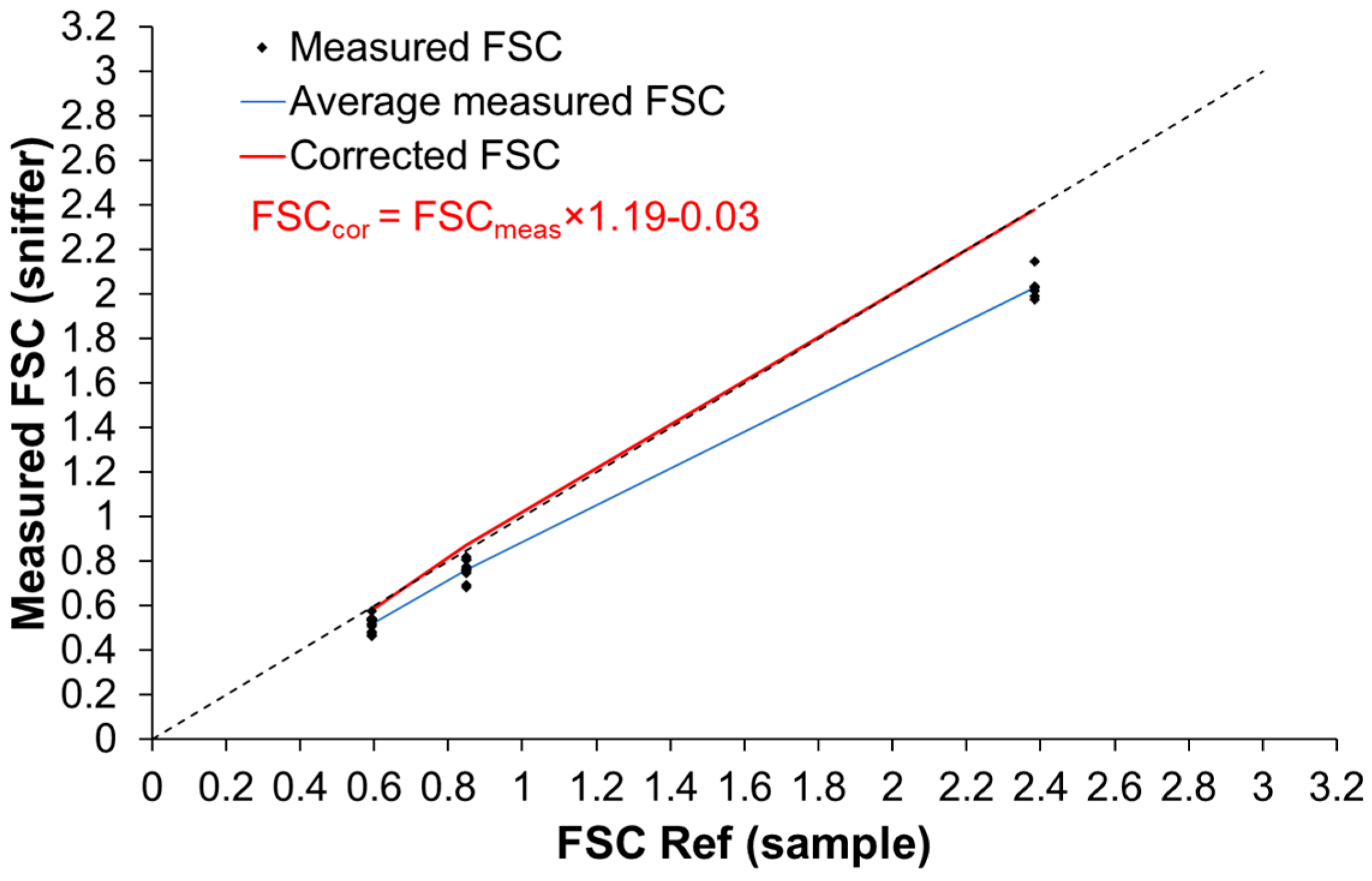

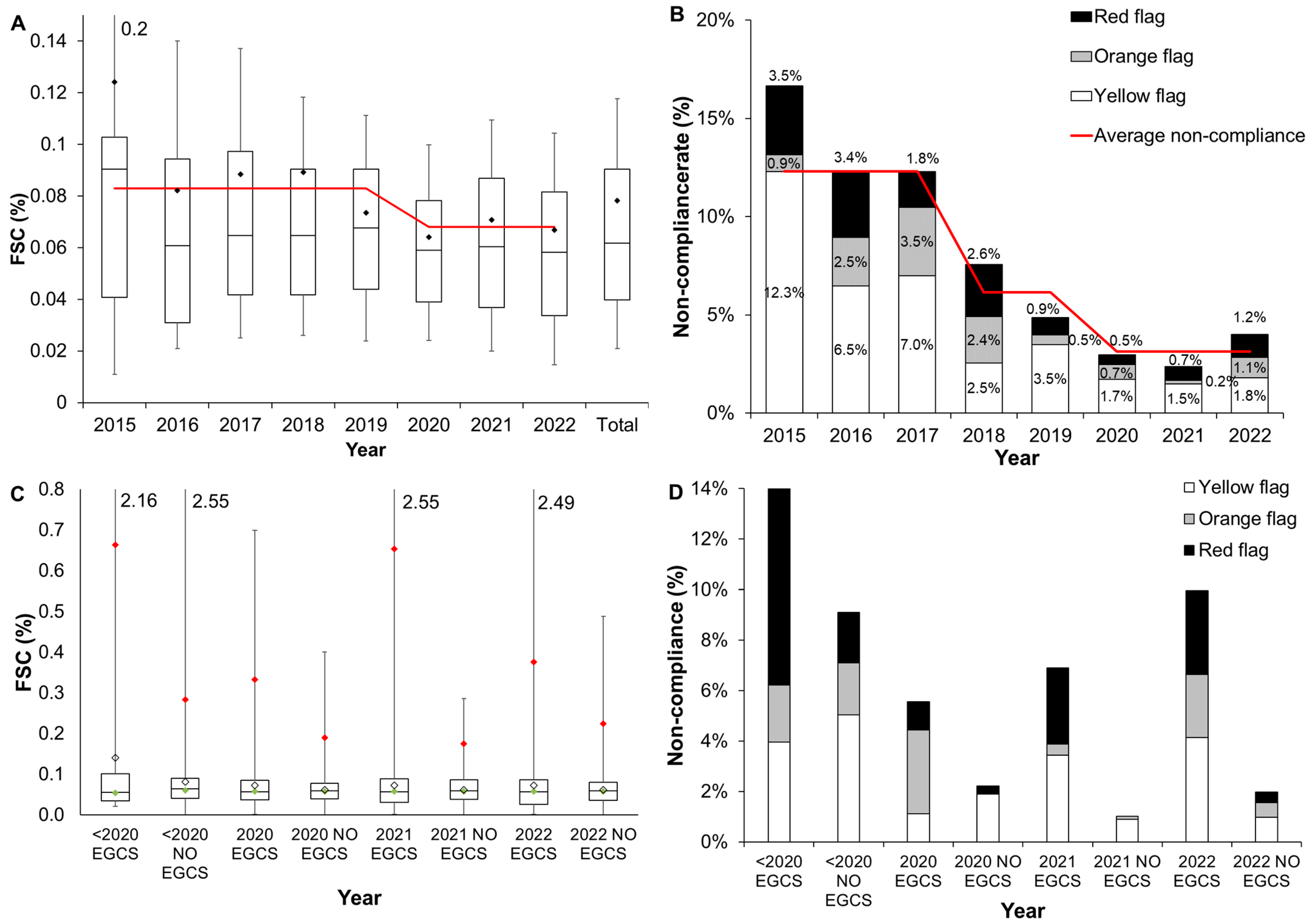
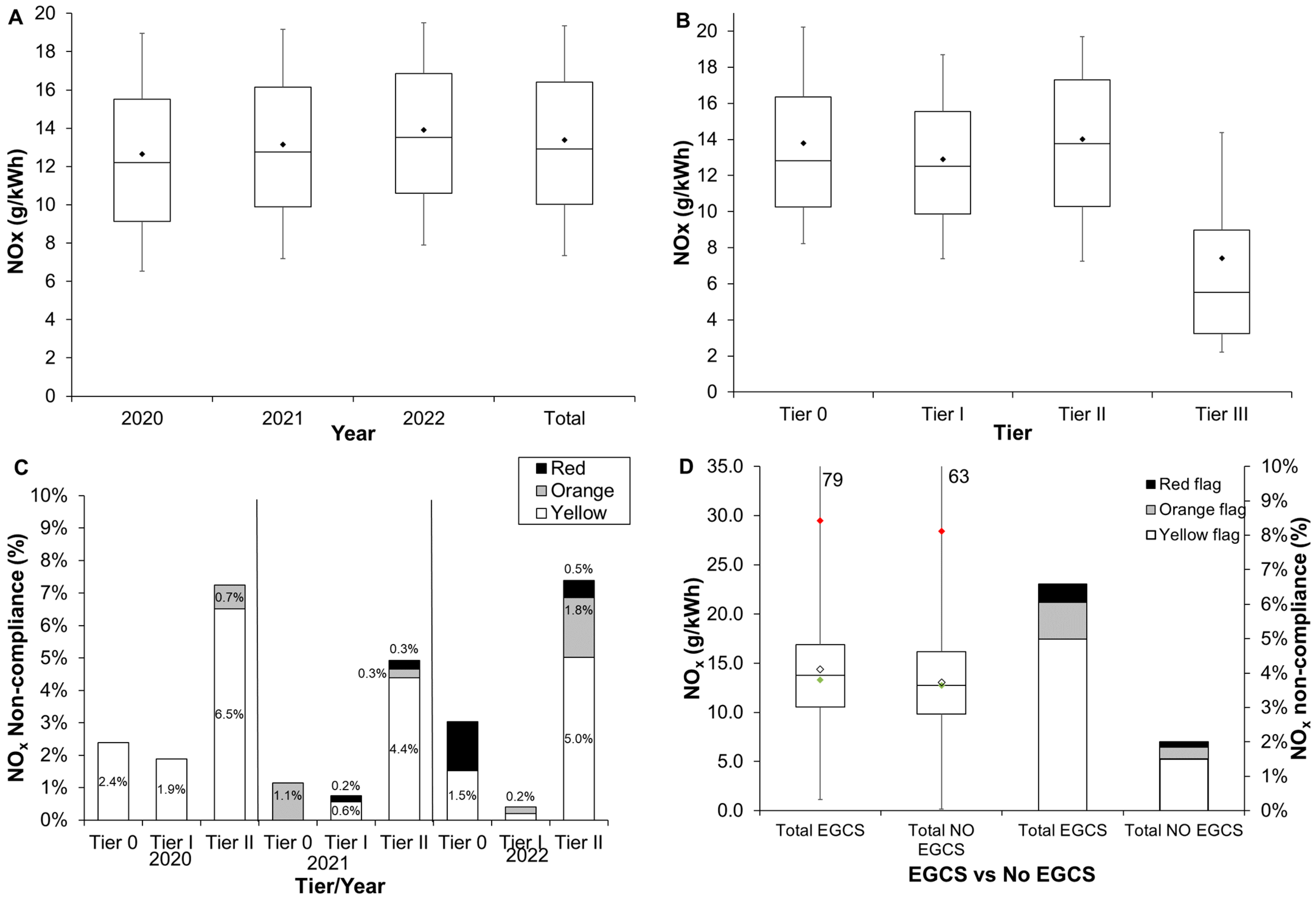
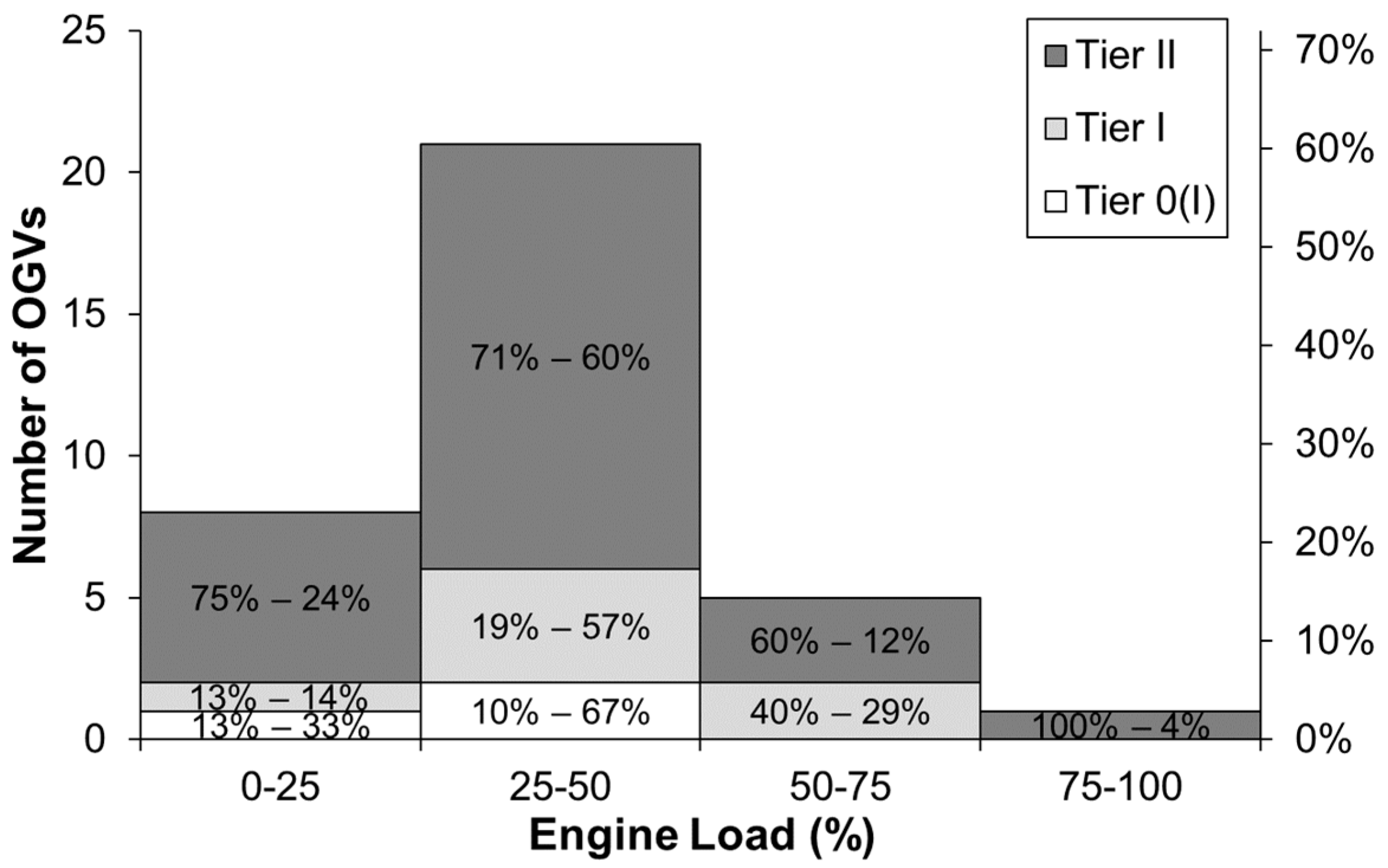
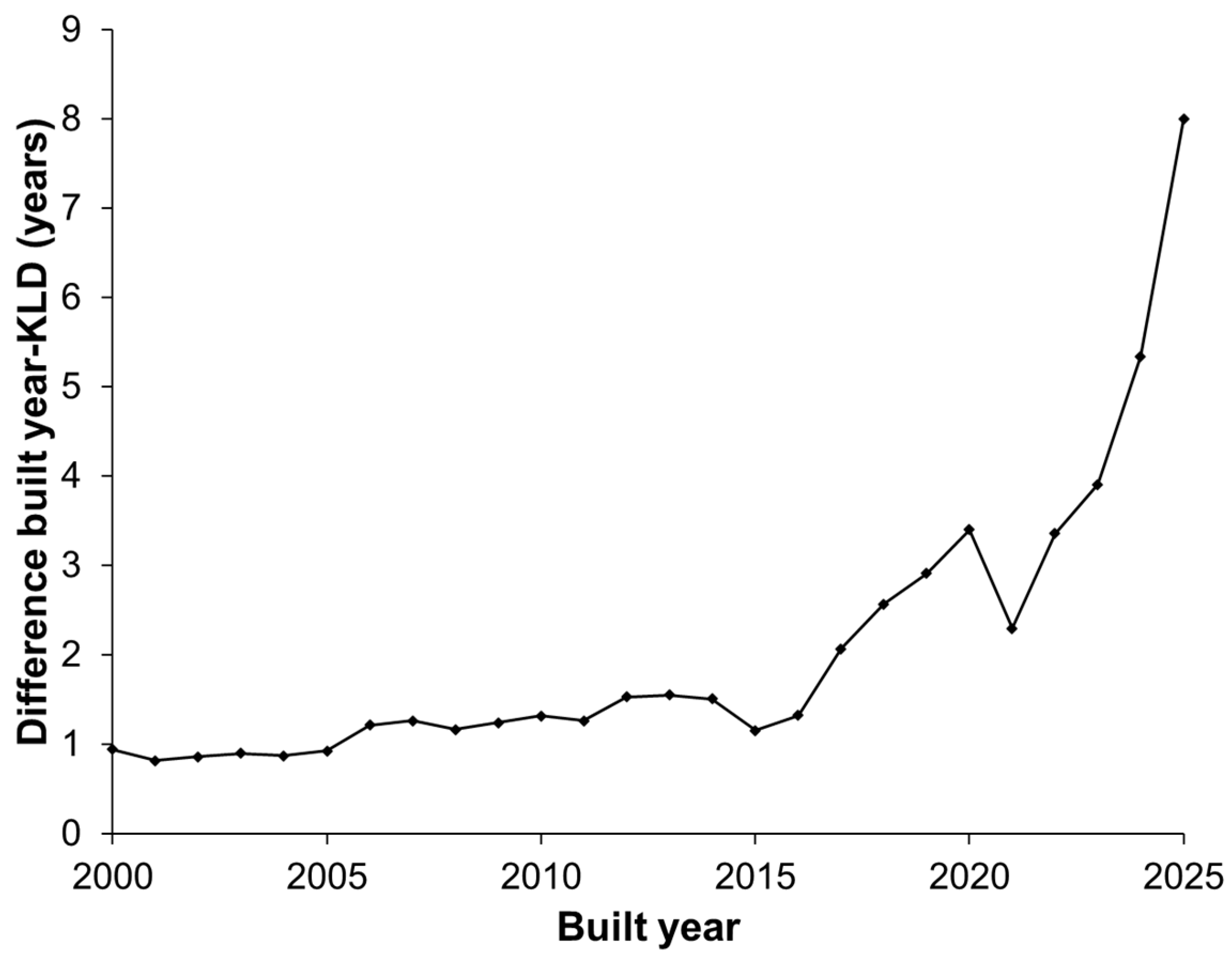
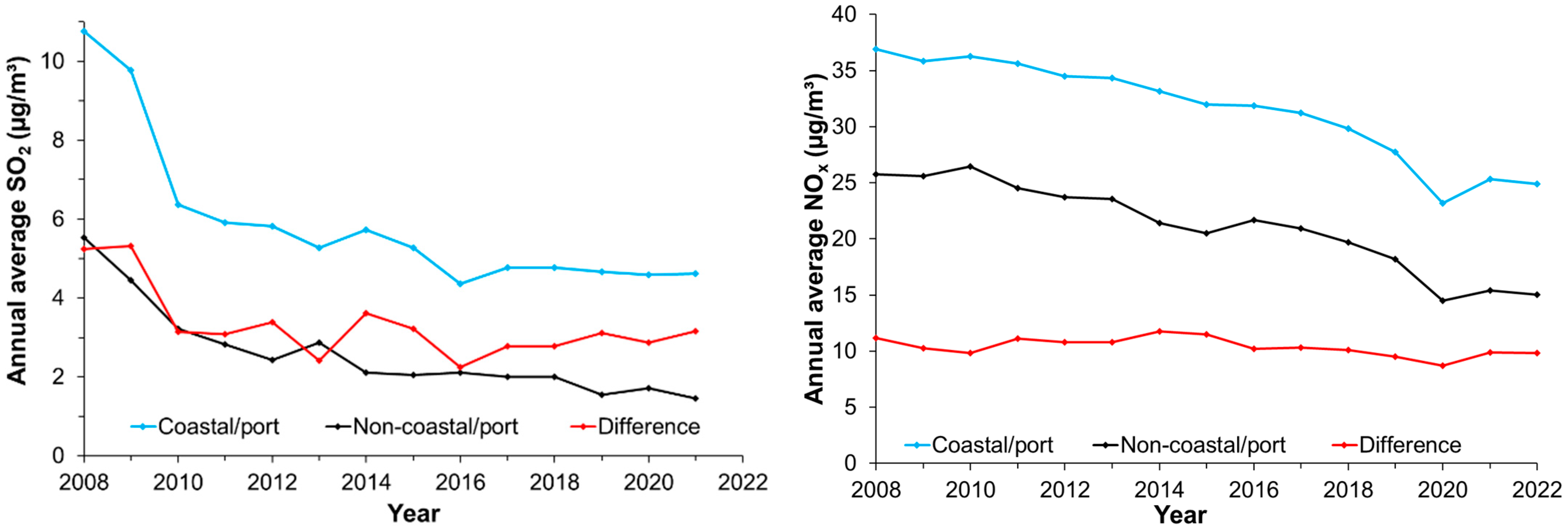
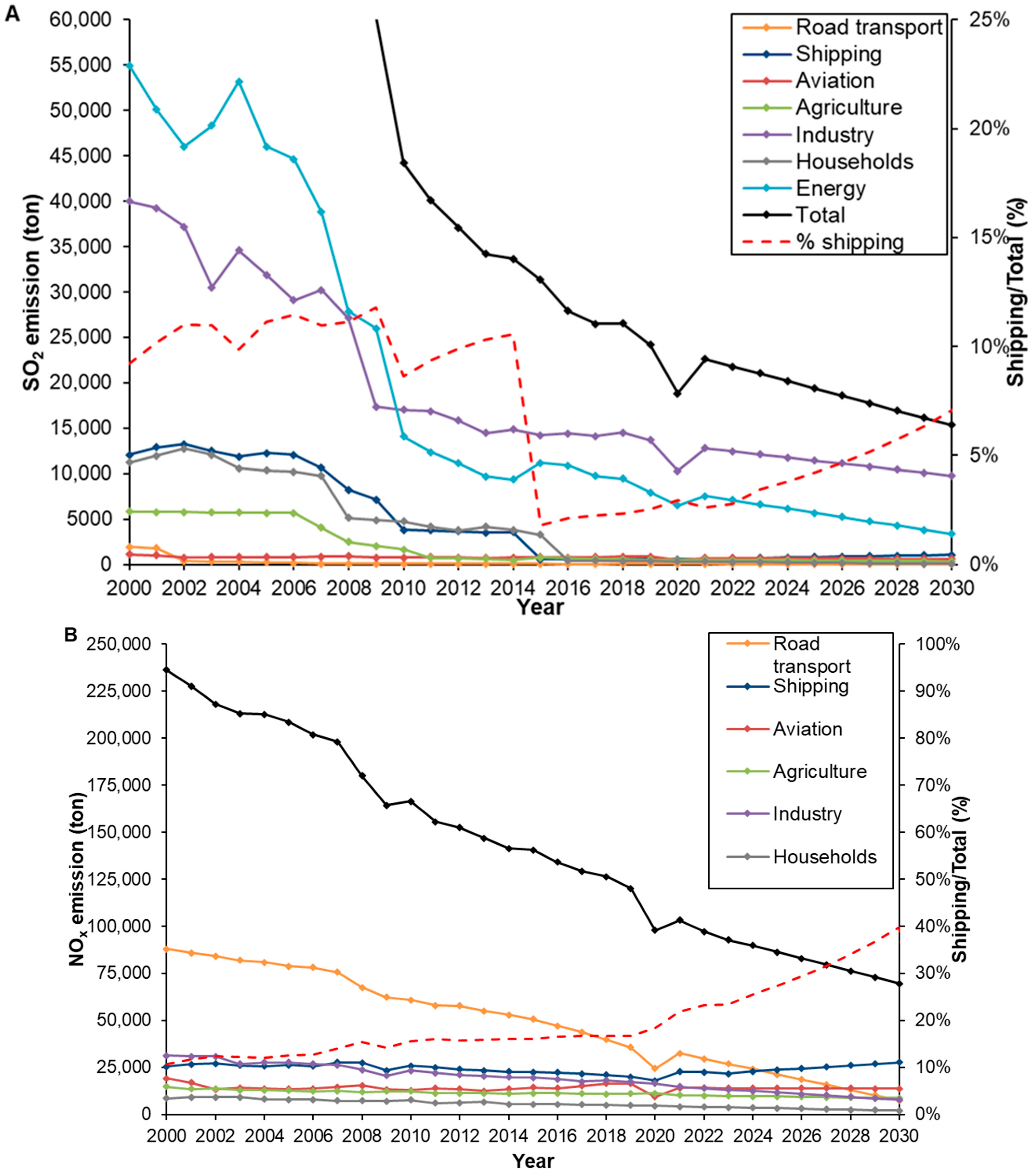
| Color Flag | σ | U | CI | Sulfur Limit | T | Tops | ||
| 2015–2019 | Yellow | 1 | 30% | 68% | 0.10% | 0.145% | 0.15% | |
| Orange | 1.96 | 35% | 95% | 0.11% | 0.174% | 0.20% | ||
| Red | 2.576 | 43% | 99% | 0.15% | 0.275% | 0.40% | ||
| 2020–2022 | Yellow | 1 | 25% | 68% | 0.10% | 0.13% | 0.13% | |
| Orange | 1.96 | 38% | 95% | 0.11% | 0.18% | 0.20% | ||
| Red | 2.576 | 48% | 99% | 0.15% | 0.29% | 0.30% | ||
| 2020–2022 (with n = 2) | Yellow | 1 | 18% | 68% | 0.10% | 0.12% | 0.12% | |
| Orange | 1.96 | 27% | 95% | 0.11% | 0.15% | 0.15% | ||
| Red | 2.576 | 34% | 99% | 0.15% | 0.23% | 0.25% | ||
| Tier | NOx Limit | Color flag | NTE | σ | U | T | Tops-20 | Tops-22 |
| Tier I | 17 | Yellow | 15% | 1 | 19.8% | 21.2 | 25 | 25 |
| Orange | 20% | 1.96 | 44.5% | 31.8 | 35 | 35 | ||
| Red | 50% | 2.576 | 58.5% | 53.2 | 60 | 55 | ||
| Tier II | 14.4 | Yellow | 15% | 1 | 19.8% | 17.9 | 20 | 20 |
| Orange | 20% | 1.96 | 44.5% | 26.9 | 30 | 30 | ||
| Red | 50% | 2.576 | 58.5% | 45.0 | 50 | 45 | ||
| Tier III | 3.4 | Yellow | 50% | 1 | 19.8% | 5.4 | 7 | 6 |
| Orange | 60% | 1.96 | 44.5% | 7.5 | 9 | 8 | ||
| Red | 65% | 2.576 | 58.5% | 8.9 | 12 | 9 | ||
Disclaimer/Publisher’s Note: The statements, opinions and data contained in all publications are solely those of the individual author(s) and contributor(s) and not of MDPI and/or the editor(s). MDPI and/or the editor(s) disclaim responsibility for any injury to people or property resulting from any ideas, methods, instructions or products referred to in the content. |
© 2023 by the authors. Licensee MDPI, Basel, Switzerland. This article is an open access article distributed under the terms and conditions of the Creative Commons Attribution (CC BY) license (https://creativecommons.org/licenses/by/4.0/).
Share and Cite
Van Roy, W.; Merveille, J.-B.; Scheldeman, K.; Van Nieuwenhove, A.; Schallier, R.; Van Roozendael, B.; Maes, F. Assessment of the Effect of International Maritime Regulations on Air Quality in the Southern North Sea. Atmosphere 2023, 14, 969. https://doi.org/10.3390/atmos14060969
Van Roy W, Merveille J-B, Scheldeman K, Van Nieuwenhove A, Schallier R, Van Roozendael B, Maes F. Assessment of the Effect of International Maritime Regulations on Air Quality in the Southern North Sea. Atmosphere. 2023; 14(6):969. https://doi.org/10.3390/atmos14060969
Chicago/Turabian StyleVan Roy, Ward, Jean-Baptiste Merveille, Kobe Scheldeman, Annelore Van Nieuwenhove, Ronny Schallier, Benjamin Van Roozendael, and Frank Maes. 2023. "Assessment of the Effect of International Maritime Regulations on Air Quality in the Southern North Sea" Atmosphere 14, no. 6: 969. https://doi.org/10.3390/atmos14060969
APA StyleVan Roy, W., Merveille, J.-B., Scheldeman, K., Van Nieuwenhove, A., Schallier, R., Van Roozendael, B., & Maes, F. (2023). Assessment of the Effect of International Maritime Regulations on Air Quality in the Southern North Sea. Atmosphere, 14(6), 969. https://doi.org/10.3390/atmos14060969











